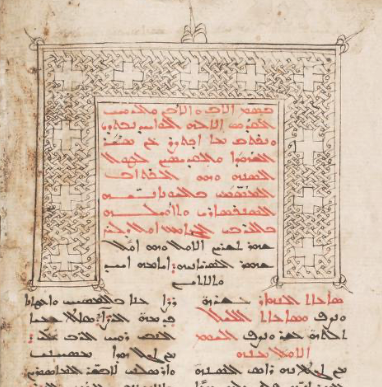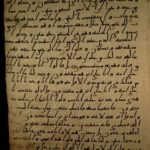
There are many who have conducted research into the truth of the writing of the Qur’ān: who was its author? When was it written? Where did the first copy of it emerge? Researchers on the origins of the Qur’ān have constructed four theories, and it is these that we will review in this article.
THE FIRST OF THESE is the theory of Muḥammad’s Qur’ān: in which the author of the Qur’ān is held to be Muḥammad the prophet of Islam himself, with the help of some of his Companions and close associates. The second is the theory of an original Syriac Christian Qur’ān: The Qur’ān was written in its first version in the Syriac language in the Karshuni Syriac script[1] and decades before Muḥammad is to have written it. The third theory is the theory of the ‘Abbāsid Qur’ān: whereby the Qur’ān was written by ‘Abbāsidjurists by order of the rulers of the Banū al-‘Abbās to establish in perpetuity their origins as belonging to the Prophet of Islam, so as to prove that they were from the house of prophecy and from the descendants of al-‘Abbās the uncle of the Prophet Muḥammad. Finally there is the theory of the Jewish-Christian Qur’ān written by the Nazarene Jews for a specific purpose.[2]
We shall go into the details of each theory.
1. Muḥammad’s Qur’ān
This is to have emerged in the desert region of Makka where Muḥammad ibn ‘Abdullah ibn ‘Abd al Muṭṭalib lived, a man who claimed to be a prophet and whose goal was to unite the Arabs in the worship of one God instead of the use of many idols to intercede on their behalf to an unknown deity.
This theory is very close to the theory of the ‘Abbāsid Qur’ān. Some historians do not accept that Muḥammad received a revelation or that Qur’ānic verses were revealed to him. They maintain that Muḥammad took the stories of the prophets from the holy books of the Jews, from the Torah and the Tanakh, and from the Gospels of the Christians. He then inserted ancient legends and some superstitions, with the addition of some texts particular to the Arab environment in Makka such as the story of Ṣāliḥ’s camel and the story of the prophet Shu‘ayb, which have no origin in the earlier holy books.
Historians also support the idea that some of Muḥammad’s Companions contributed to the writing of some of the verses, Companions uch as ‘Umar ibn al-Khaṭṭāb, who said: “I agreed with my Lord in three things”. That is, there are three verses in the Qur’ān that he had said verbatim on different occasions. Among the Companions who participated in writing verses of the Qur’ān and who helped Muḥammad in this task were the Christian priest Waraqa ibn Nawfal, who brought up Muḥammad since he was the cousin of Khadīja bint Khuwaylid, Muḥammad’s wealthy wife. Waraqa ibn Nawfal was the one who told Muḥammad that he had become a prophet. There were also the cultured Zoroastrian Companion Salmān the Persian, the Jewish rabbi ‘Abdullah ibn Salam, Baḥīrā the monk an expert in the religious sciences and the holy books, and the Jew Zayd ibn Thābit ibn Ḍaḥḥāk, who was the amanuensis of the Prophet and the keeper of his secrets.
The entire history of Islam is made up of fantasy and unreal, it is based on the myth of the existence of Makka and the tribe of Quraysh
All this is according to the ‘Abbāsid narration. Some sayings of ‘Umar ibn al-Khaṭṭāb were also added to verses of the Qur’ān, which he acknowledged in saying: “I agreed with my Lord in three things”. What is meant by this is that three of his sayings were written into the text of the Qur’ān because they were consistent with what the Revelation said. But the truth is that it is what ‘Umar ibn al-Khaṭṭāb had said in certain circumstances that was subsequently approved by Muḥammad and reproduced verbatim in the Qur’ān as a text of the Revelation. These included whether the shrine of Abraham was to be made a prayer room, and his threatening of the wives of the Prophet that, should the Lord divorced them from him, he would marry him to women better than them – widows and virgins.[3]
There is also the famous saying in praise of God’s creation made in describing the stages of formation of the embryo in the womb. ‘Umar said: “Blessed be Allah, the best of Creators” which Muḥammad quoted literally in the Qur’ān.[4] (Note that there is a mistake in this phrase, which is that there are not several creators that God should be the best of them; the Creator is the one and only God. How can there be a ranking of the Creators so that Allah is the best of them?) Another phrase uttered by ‘Umar: “Who is an enemy to Allah, and His angels and His messengers, and Gabriel and Michael! Then, lo! Allah (Himself) is an enemy to the disbelievers”[5] is quoted in the Qur’ān as if it were a revelation from heaven and not from ‘Umar.

Suggested Reading
The hypothesis of Muḥammad’s authorship of the Qur’ān has collapsed because historians have proven that Makka did not exist historically or geographically before the era of ‘Abbāsid rule. Everything written on this was forged and invented. There is no mention of Makka in ancient manuscripts, no historical traces whether above or below the ground, and no documents demonstrating this or speaking of it. The Qur’ān of Muḥammad thus has no basis for its existence prior to the ‘Abbāsid period; everything written about Muhammad and his adventures was authored by the ‘Abbāsid fuqahā’.
The entire history of Islam is unreal and made up of fantasy. It is based on the myth of the existence of Makka and the tribe of Quraysh whose historical existence in the seventh century has not been proven. Other evidence to support this is the fact that the geography of the Qur’ān does not correspond to the geography of the desert region of Makka. There are verses in the Qur’ān that mention rivers and orchards, and fruits such as figs and olives, and the sea and its storms. But in the Qur’ān there is no mention of the desert of Makka and its dust storms. Most most of the Qur’ān’s hadiths are about the Mediterranean coast such as Syria, Lebanon and the Levant with its orchards and fruits. There is no description of the desert of Makka and its environment.
[1] Karshuni (or Garshuni) is the Syriac alphabet when used for other languages, principally Arabic. It originated in the seventh century when Arabic was becoming the dominant spoken language in the Fertile Crescent but when the Arabic alphabet was not yet fully developed.
[2] For works on this theory see the Almuslih Library under the rubric The ‘Jewish-Christianity’ theory.
[3] The passage in the Qur’ān is sūrat al-Taḥrīm, 5: Maybe, his Lord, if he divorce you, will give him in your place wives better than you, submissive, faithful, obedient, penitent, adorers, fasters, widows and virgins.
[4] The quote is at sūrat al-Mu’minīn, 14. Then We made the seed a clot, then We made the clot a lump of flesh, then We made (in) the lump of flesh bones, then We clothed the bones with flesh, then We caused it to grow into another creation, so blessed be Allah, the best of the creators.
[5] Qur’ān II (al-Baqara), 98.
Main image: An Arabic language manuscript in Karshuni script of a Synaxarion (‘Collection’) of abridged lives of the saints for use in church services. From the church of St. George, Urfa, now in the Library of Congress, USA. The text in Arabic letters reads: بسم الاب والابن والروح القدس الاله الواحد نبتدي ونكتب ما اختصر عن سير الشنودا والقديسين لطول السنة وهو الكتاب المسمى باليونانية السنكساري In the name of the Father and the Son and the Holy Spirit, One God, we commence the writing of a brief account of the lives of Shenouda and the Saints, for use the year round, and this book in Greek is called the ‘Synaxarion’.
